Don't wanna be here? Send us removal request.
Text
What is real-time agent assistance in contact centers?
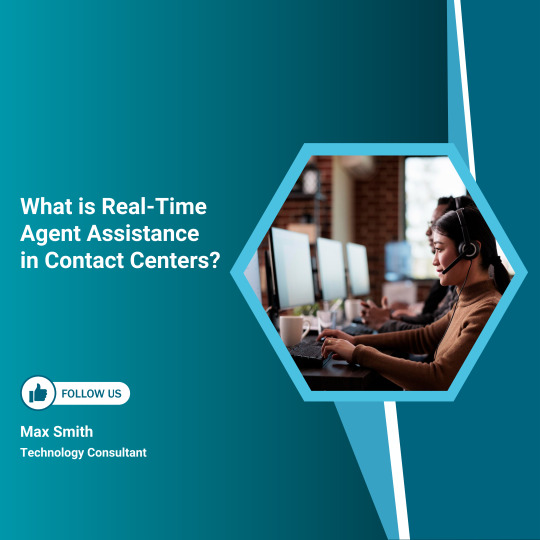
Real-time agent assistance is an innovative technology that supports contact center agents during live customer interactions. It delivers instant, context-specific help, guiding agents with prompts, knowledge, and compliance checks exactly when needed. This leads to stronger operations and better customer experiences.
Contact centers face growing complexity. Customers expect fast, accurate, and tailored service. At the same time, agents must handle more products, stricter compliance rules, and rising interaction volumes. This pressure often means longer calls, more mistakes, and lower customer satisfaction.
Real-time agent assistance directly solves these issues by using AI and machine learning inside live conversations.
How real-time agent assistance impacts business
Contact centers that use real-time agent assistance see clear, measurable gains. Recent data shows:
23% shorter average handle time (AHT): Agents get quick answers and next-best-action prompts, solving problems faster.
31% boost in first contact resolution (FCR): Real-time help ensures agents fix issues fully on the first call.
27% fewer agent errors: Automated compliance alerts and script reminders cut down on costly mistakes.
19% rise in customer satisfaction (CSAT) scores: Customers receive more precise and confident support.
These improvements lower operational costs and drive more value from each customer. Shorter calls let teams handle more interactions without extra staff, while fewer escalations free up managers and specialists.
Key features that deliver these results
Top real-time agent assistance tools include:
Live speech or chat analysis: Detects keywords, customer mood, and intent to give instant guidance.
Dynamic knowledge delivery: Sends the right articles, product details, or troubleshooting tips directly to the agent’s screen.
Compliance support: Warns agents if a legal disclosure is missing or a rule might be broken.
Smart scripting: Keeps conversations consistent and ensures all needed information is collected.
On-the-spot coaching: Highlights skill gaps and recommends micro-learning content, building agent confidence during calls.
These tools help new agents ramp up faster and enable all agents to handle complex issues with less stress.
Why it’s a strategic move
Real-time agent assistance is more than just a tech upgrade. It’s a shift toward smarter, more proactive operations. Industries like banking, insurance, telecom, and healthcare rely on this to protect both brand trust and compliance.
It also lowers agent stress. Contact centers typically face 30-45% yearly agent turnover. By reducing cognitive strain, companies keep experienced agents longer, save on hiring, and maintain better service quality.
Vanie Real-Time Agent Assistance provides these benefits by training agents using AI to support them throughout each customer engagement. It is simple to integrate its platform into other systems, providing real-time insights, compliance control, and contextual recommendations. The outcomes are evident: increased productivity, reduced errors, and improved customer loyalty.
#RealTimeAgentAssistance#ContactCenterAI#CustomerExperience#AgentProductivity#CSAT#FirstContactResolution#AIinCustomerService#ContactCenterSolutions#ReduceAHT#ComplianceManagement
0 notes
Text
What is personalized agent coaching and how does it improve contact center performance?
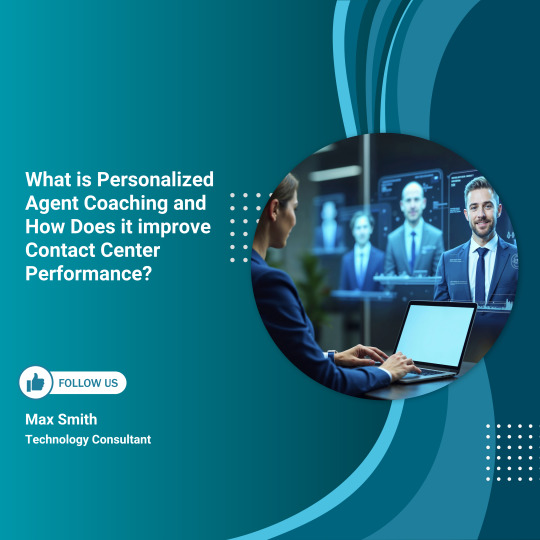
Personalized agent coaching is a focused approach to developing contact center teams by addressing each agent’s specific skill gaps and strengths. Unlike traditional training programs that take a one-size-fits-all approach, personalized coaching uses data from actual customer interactions across voice, chat, or email—to tailor feedback and guidance for every individual.
This method delivers strong business results. Companies that implement personalized coaching typically see improvements in first contact resolution (FCR), average handle time (AHT), customer satisfaction (CSAT) and net promoter scores (NPS). By targeting coaching efforts to the exact needs of each agent, organizations build teams that handle customer issues more effectively and consistently.
It also has a clear impact on employee engagement and retention. When agents receive support that is directly tied to their performance, they feel more valued and equipped to do their jobs well. This minimizes turnover, which is essential considering that a single agent replacement may bring the amount of 30% of their annual compensation, taking into consideration hiring, training, and reduced productivity.
Personalized coaching also ensures customer interactions align with the company’s brand standards and compliance needs. For regulated sectors like banking or healthcare, coaching that’s tailored to each agent helps meet strict compliance requirements while still delivering a positive customer experience. In industries such as technology or SaaS, it enables agents to handle complex issues that could otherwise jeopardize key accounts or recurring revenue.
Modern contact centers often use AI-enabled platforms to drive personalized coaching. These systems analyze conversations for factors like tone, compliance and issue resolution. They then generate targeted coaching plans or micro-learning modules for each agent. This moves coaching from subjective manager observations to an objective, metrics-driven process.
In the end, personalized agent coaching transforms contact centers from basic support operations into strategic assets. It improves customer experience, cuts inefficiencies, and builds high-performing teams that protect revenue and customer relationships.
Companies like Vanie ai embed personalized agent coaching into their contact center strategy to position themselves to achieve stronger customer loyalty and improved operating margins. This approach goes well beyond traditional people initiatives—it serves as a proven catalyst for long-term business value, driving both revenue protection and growth.
0 notes
Text
What is conversational AI, and what are its benefits?

Conversational AI is technology that allows businesses to interact with customers through automated, natural language conversations. It utilizes a combination of natural language processing (NLP), machine learning, and speech recognition to understand and respond to customer questions in real-time—whether over voice calls, chat, or messaging platforms.
For organizations focused on efficiency and growth, conversational AI is proving to be a critical investment. The benefits extend across cost, customer experience, sales and decision-making.
Key business benefits of conversational AI
1.Significant cost savings
Conversational AI can resolve up to 80% of standard customer queries, reducing the burden on human agents. IBM reports businesses spend more than $1.3 trillion annually to handle customer requests, and conversational AI can cut these costs by as much as 30%. This makes it a powerful tool for managing budgets without sacrificing service quality.
2.Better customer experiences
Customers expect quick, accurate answers—often around the clock. Conversational AI delivers immediate, consistent responses 24/7. A PwC study shows 73% of customers point to experience as a top driver of their buying decisions. AI ensures these interactions meet expectations, increasing satisfaction and long-term loyalty.
3.Boosted sales and revenue opportunities
Conversational AI doesn’t just resolve support tickets; it also captures buying signals, qualifies leads and suggests relevant products or upgrades. According to Salesforce, 51% of sales leaders are already using AI tools to gain deeper customer insights that fuel growth.
4.Smarter, data-driven decisions
Every conversation processed by AI becomes a data point. Over time, this builds a rich view of customer sentiment, preferences and emerging needs. Businesses can use these insights to adjust product strategies, refine messaging, or improve service operations—all backed by real interaction data.
5.Scalability without added strain
Conversational AI is capable of engaging thousands of customers in simultaneous conversations, unlike human teams who are working in shifts and limited by a number of people. This scalability is necessary when high demand or fast-growth exists. It helps customers to get the help they need on time, and the voice of the brand remains the same.
Where Conversation Intelligence comes in
Conversational AI also sets the stage for advanced tools like Conversation Intelligence. This technology analyzes conversations to reveal patterns, identify compliance issues, and pinpoint what drives successful outcomes.
Companies that use platforms such as Vanie’s Conversation Intelligence turn these insights into clear business actions. They improve agent coaching, close more deals, and keep customer interactions aligned with overall strategy. This transforms everyday conversations into a measurable advantage—driving higher margins and stronger customer relationships.
0 notes
Text
What Are the Key Features That Drive High First Contact Resolution in Omnichannel Services?
First Contact Resolution (FCR) is one of the most important metrics in omnichannel customer service. It measures the ability to resolve client issues in the very first interaction—without follow-ups, call-backs, or escalations. High FCR improves customer satisfaction, reduces costs, and strengthens brand credibility. According to SQM Group, a 1% rise in FCR equals a 1% improvement in customer satisfaction. In a multi-channel environment, this directly impacts business results.

1. Centralized Customer Data Across Channels
FCR starts with complete visibility. Agents must be able to view customer interactions across phone, chat, email, social media, and self-service tools. When all data is stored in one place, service becomes faster and more accurate. A Forrester report shows 68% of customers feel frustrated when they have to repeat themselves due to disconnected systems. A unified view enables smoother conversations and quicker resolutions.
2. Smart Routing and Agent Matching
Directing queries to the most suitable agent from the start improves FCR significantly. Intelligent routing systems use AI to match issues with agents who have the right skills and knowledge. This reduces call transfers and escalations. Genesys research shows that companies using skill-based routing see up to a 25% increase in FCR. The right match reduces response time and improves Omnichannel Customer Service
satisfaction.
3. Real-Time Support Tools for Agents
Real-time tools help agents respond faster and with more accuracy. AI-driven prompts, knowledge base suggestions, and sentiment analysis make it easier for agents to understand the issue and act immediately. When agents have access to a shared knowledge base, across all channels, they can provide consistent, correct answers—whether through chat, phone, or social support.
4. Proactive Communication Reduces Inbound Volume
Companies can help inbound traffic and increase FCR by detecting issues ahead of time and informing the customer of the problem in advance. Issues are resolved without customers having to contact them using alerts, Frequently Asked Questions, and real-time service upgrades. According to Aberdeen Group, implementing proactive support strategies decrease subsequent contacts by up to 20%.
5. Channel-Specific Setup & Optimization
Different channels of services are optimal when used with appropriate tools and workflow. Live chat is more effective when scripted pick-ups and typing previews are involved and social media care should have sentiment detecting tools and rapid tagging. As compared to the one-process-fits-all approach, optimizing each channel separately promptly resolves issues and results in an increased FCR.
6. Feedback-Driven Improvement
Tracking FCR in real time helps teams see what’s working and what isn’t. In an Omnichannel Customer Service environment, post-interaction surveys and automated reports help identify issues that weren’t resolved the first time—across voice, chat, email, and social channels. Companies that use FCR data to improve agent training and service design see better long-term results. Top teams treat FCR as a core performance KPI.
7. Smooth Transition from Bots to Humans
Automation is useful, but some problems need a human touch. When chatbots hand off to live agents, all the information should carry over—without the customer having to repeat their issue. Gartner reports that this kind of seamless handoff increases Omnichannel Customer Service
satisfaction by 15%. It also cuts down resolution time.
Omnichannel Customer Service Platforms That Support High FCR
Companies that want to improve FCR at scale need strong platforms. Suma Soft, Salesforce Service Cloud, Freshdesk, and Genesys Cloud offer end-to-end Omnichannel Customer Service.
High First Contact Resolution is not just a metric—it’s a customer experience standard. With the right omnichannel tools, businesses can reduce support costs, improve satisfaction, and strengthen brand trust.
#FirstContactResolution#OmnichannelSupport#CustomerExperience#CXStrategy#CustomerSatisfaction#SupportMetrics#DigitalCustomerService#CXOptimization#CustomerSupportSuccess#FCRMatters
2 notes
·
View notes
Text
Can Live Chat Support Services Help Convert Website Visitors into Leads and Customers?
In today's competitive digital economy, businesses are under pressure to convert every potential interaction into a measurable opportunity. Website traffic alone does not guarantee conversions. The critical differentiator lies in real-time engagement—and Live Chat Support Services have emerged as a proven, scalable solution to address this challenge.

The Evolution from Passive Browsing to Active Engagement
Static websites no longer meet the demands of the modern buyer journey. According to Forrester, 53% of online users are likely to abandon a site if they do not find quick answers to their questions. Live chat bridges this gap by initiating dialogue at critical decision points. Instead of waiting for users to fill out a contact form or call a helpline, chat agents proactively guide visitors toward conversion paths.
Business Impact: From Interaction to Revenue
Live chat support is more than a customer service channel—it's a revenue enabler. The benefits extend across industries and customer lifecycle stages:
Higher Conversion Rates: Research by Invesp indicates that customers who utilize live chat are 2.8x more likely to convert reached to those who don't engage. Immediate answers reduce bounce rates and create confidence in the brand.
Reduced Response Time: Live chat support cuts the average customer wait time down to less than 1 minute, improving satisfaction levels and reducing the risk of prospect drop-off during the discovery phase.
Personalized Lead Qualification: Advanced chat support systems integrate with CRMs and marketing automation tools. This allows agents to collect qualifying data during chats—such as budget size, industry, and urgency—so that sales teams engage only with high-intent leads.
24/7 Sales Enablement: With global operations and time zone differences, businesses benefit from 24/7 live chat support. This uninterrupted engagement model ensures no lead opportunity is missed, regardless of visitor location.
Lower Cost per Acquisition (CPA): Compared to traditional call centers, live chat significantly reduces operational costs. One live chat agent can handle 3 to 5 simultaneous chats, unlike phone agents who manage a single interaction at a time.
User Experience as a Lead Magnet
The conversion is determined by user experience. Live chat delivers a human touch to online interactions- lessening the friction and increasing trust. When used wisely, it serves as a support mechanism and lead grabber. The incorporation of pre-chat forms, chatbot qualifiers and instant file-sharing features add to the worth of individual sessions.
Enterprises that use AI-enabled live chat services can automate
repetitive questions and pass difficult tasks to humans. This hybrid allows both high quality of services and horizontal expansion.
Metrics That Matter
73% of customers find live chat the most acceptable form of communication with a company (eConsultancy).
Businesses that use live chat see an average 20% increase in conversions (Kayako).
63% of users are more possible to return to a website that shows live chat (Emarketer).
These metrics indicate a clear ROI pathway for integrating live chat into the customer acquisition funnel.
Outsourcing live chat support services can deliver faster implementation, multi-language capabilities, and round-the-clock operations. Companies such as Suma Soft, Helplama, HelpSquad, and TextChat are known for their industry-specific expertise and scalable support models.
For B2B companies seeking to maximize digital conversion rates while optimizing operational spending, live chat support is not optional—it's a strategic imperative.
#LiveChatSupport#CustomerExperience#DigitalEngagement#RealTimeSupport#B2BMarketing#CustomerServiceSolutions#ConversionOptimization#UserExperienceDesign#LeadGenerationStrategy#SalesEnablement#SupportAutomation#CustomerSatisfaction#BusinessGrowthStrategy#OmnichannelSupport#DigitalCustomerService
3 notes
·
View notes
Text
What Role Does Agile Methodology Play in Accelerating Software Product Development?

In today’s digital economy, speed matters. Organizations building digital products must deliver faster, adapt to market changes, and meet growing customer demands—all without compromising quality. That’s where Agile methodology plays a critical role in software product engineering.
Agile has become a core strategy for companies looking to streamline development, reduce time-to-market, and drive better product outcomes. Unlike traditional development models that follow a rigid sequence, Agile supports iterative development, continuous feedback, and closer alignment with business objectives.
How Agile Supports Faster, Smarter Software Product Engineering
1. Speeds Up Product Releases
Agile divides large projects into smaller development cycles, called sprints. These short, focused cycles enable teams to build and release functional versions of the product quickly.
According to the 15th State of Agile Report, 64% of organizations saw faster delivery after adopting Agile. Early releases also allow teams to validate ideas in real market conditions and adjust faster.
2. Improves Product Quality
In Agile, testing is built into every step. Features are tested continuously as they're developed, which helps catch bugs early and improve code quality. Frequent code reviews and automation also reduce human error.
Companies using Agile see 30–50% fewer defects than those using traditional methods.
3. Aligns Teams with Business Goals
Agile can get the stakeholders and development teams to meet frequently. Sprint planning, demos, and review keeps all people in the same direction regarding the objectives and the progress. This will guarantee the clarity on requirements of the business and the product roadmap.
A PwC study found Agile projects are 28% more successful in meeting business objectives.
4. Adapts to Change Easily
Market trends shift quickly. Agile teams can adapt without disrupting the entire project. By updating priorities in the product backlog, teams stay focused on high-impact work and respond to customer feedback or regulatory changes with agility.
5. Reduces Project Risks
Because Agile works in small steps with regular reviews, it becomes easier to spot and resolve issues early. Tools like burndown charts and velocity metrics provide better visibility and help manage timelines more accurately.
This leads to more predictable delivery and fewer costly surprises.
The Business Impact of Agile in Product Engineering
21% improvement in project visibility and reporting
19% boost in team productivity
60% of enterprises say Agile helped them release software faster
Agile isn't just a development process—it’s a business enabler. It supports cross-functional collaboration, faster innovation, and better alignment between IT and business. In software product engineering, this translates into reduced waste, higher ROI, and better customer satisfaction.
Leading Agile Software Product Engineering Providers
Several companies have embedded Agile into their product engineering services to deliver scalable and adaptive digital solutions. Notable providers include: Suma Soft, Infosys, HCLTech, Persistent Systems, and Globant.
These companies help enterprises across industries accelerate digital transformation through Agile-based software product engineering.
#AgileDevelopment#SoftwareProductEngineering#AgileTransformation#ProductDevelopment#AgileEngineering#DevOpsCulture#DigitalInnovation#EngineeringExcellence#ProductStrategy#ScrumTeams
3 notes
·
View notes
Text
What Are the Key Steps in Building an Effective Data Pipeline for Your Business?
In today’s data-centric economy, businesses are inundated with information from numerous sources—CRM platforms, marketing tools, transactional systems, and more. Without a structured data pipeline, this wealth of information remains fragmented and underutilized. Data Engineering Services help transform this raw data into a reliable asset, enabling organizations to make faster, data-driven decisions.

An effective data pipeline is not built on tools alone—it requires a well-defined, stepwise approach that aligns with business goals. Below are the essential steps that ensure a robust and scalable data pipeline.
1. Requirement Analysis and Data Source Identification
The initial stage is the identification of business objectives which should be facilitated by the pipeline. Bringing out the clarity on the use-cases defines the design of the pipeline whether it is enhancing customer segmentation, predicting the demand, streamlining supply chains etc.
Then locate and list all possible data sources (external and internal). This involves APIs, databases, log files, social media feeds and third party platforms. A thorough source map helps reduce the data silos risk.
2. Data Ingestion Strategy
The ingestion of data needs to be designed according to volume, velocity and variety. Batch processing is appropriate with large static data sources whereas with real-time ingestion clickstreams, transaction logs or sensor data are good applications.
The ingestion framework is a high availability, fault-tolerant pattern usually implemented with a message broker (e.g., Kafka) or a data ingestion platform such as Apache NiFi or AWS Kinesis.
3. Data Transformation and Cleaning
Raw data is rarely analytics-ready. Data engineering Services teams apply rules, filters, joins, and standardizations to cleanse the data. Common transformation processes include:
Removing duplicates and null values
Formatting timestamps and currency
Normalizing data structures for consistency
Poor data quality can reduce analytics effectiveness by 40%, according to a 2023 Experian study.
4. Data Storage and Modeling
Selecting the right storage system depends on data size, access frequency, and query performance needs. Cloud-based data lakes (e.g., Amazon S3, Azure Data Lake) or data warehouses (e.g., Snowflake, BigQuery) are often used.
Modeling the data into structured formats, such as star or snowflake schemas, enables efficient reporting and business intelligence. Data engineers should align modeling techniques with intended analytical queries to minimize latency.
5. Workflow Orchestration and Automation
Automation guarantees reliability and repeatability. Data workflows are scheduled, monitored, and managed using tools, such as Apache Airflow or Prefect, around which workflows can be automated and less frequently duplicate manually, decreasing human intervention and workflow errors.
A coordinated pipeline minimizes outages and guarantees data availability between departments which are vital to time-sensitive decisions.
6. Monitoring and Quality Checks
Automated monitoring structures are used to detect anomaly, data accuracy and schema integrity. The main metrics to follow are:
Latency of data, and data throughput
Failed ingestion attempts
Schema mismatches
Time to execute pipeline
A report by Gartner estimates that companies using automated data tests can reduce the number of data errors in their operations by up to 60%.
7. Security and Compliance
The data pipelines should meet regulatory requirements such as GDPR, HIPAA, or ISO 27001. Secure data pipelines are non-negotiable: encrypt data in transit, encrypt data at rest, apply access controls, and keep audit logs.
Role of Data Engineering Services
The use of Outsourcing to special Data Engineering Services helps boost pipeline development and decreases internal overheads. These service providers can provide end-to-end solutions-architecture design, deployment, and maintenance.
Companies such as Suma Soft, Sigmoid, Acceldata, Databricks, and ThoughtSpot deliver scalable data engineering services capabilities to enterprises across the finance, healthcare, retail, and manufacturing sectors.
An effective Data Engineering Services pipeline is not just an IT asset—it’s a business growth enabler. With the right foundation in place, organizations can turn fragmented data into real-time, actionable insights—driving performance, innovation, and market competitiveness.
#DataEngineeringServices#DataPipelineStrategy#ModernDataArchitecture#DataDrivenDecisions#ETLAndDataPipelines#BigDataTransformation#CloudDataInfrastructure#RealTimeDataInsights#DataWorkflowAutomation#SecureDataPipelines#EnterpriseDataStack#DataQualityMatters#BusinessDataAnalytics#OutsourceDataServices#DataOpsBestPractices
3 notes
·
View notes
Text
The Need for Legacy Application Modernization?
In today’s fast-moving digital economy, outdated software systems are more than just technical debt—they're barriers to business growth. Legacy system modernization may have once driven core operations, but they now struggle to meet modern demands around agility, security, and cost-efficiency.
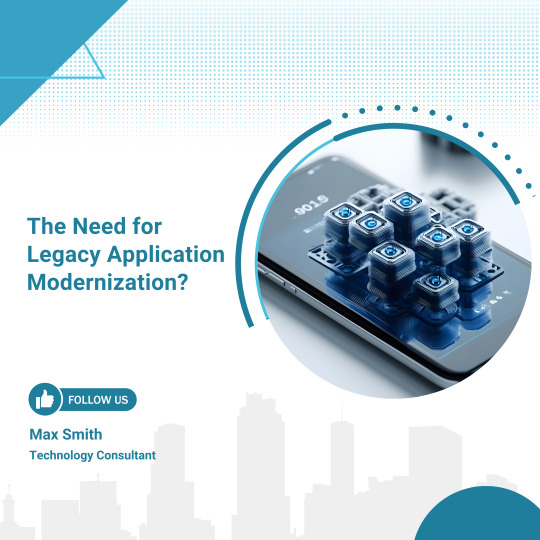
Why Legacy Systems Are Holding Businesses Back
High Maintenance Costs: Legacy systems are expensive to maintain and operate. According to Gartner, enterprises spend 60% to 80% of their IT budgets on maintaining these outdated platforms. Costs accumulate through licensing fees, outdated hardware, and the need for niche skills that are becoming increasingly difficult to find.
Integration Challenges: Older systems often lack the ability to integrate seamlessly with modern platforms. They are incompatible with APIs, cloud tools, as well as automation technologies. This creates data silos, manual work and restricted digital collaboration.
Increased Security Risks: Security is a growing concern. Legacy platforms often don’t support modern cybersecurity protocols. A Flexera report from 2024 indicates that 72% of enterprises consider legacy vulnerabilities a key risk. Unsupported software increases the chances of breaches and non-compliance.
Poor Scalability and Innovation: These systems lack scalability. As a result, businesses struggle to innovate or introduce new services to the market. Teams end up spending time patching problems instead of building better solutions.
Key Benefits of Legacy System Modernization
Efficiency Gains: Modern systems automate manual tasks and support efficient workflows. A Deloitte study found that companies moving to modern platforms saw an average 30% improvement in operational efficiency.
Better Customer Experiences: The new systems provide quicker interaction and accommodate customized services. They facilitate live support across channels that is paramount in client retention and satisfaction.
Faster Product Launches: With newer architectures like microservices and DevOps support, businesses can launch products more quickly. This agility is crucial in industries where speed is a key competitive advantage.
Smarter Decision-Making: There is enhanced data accessibility on modern platforms. The use of real-time analytics and dashboards can help decision-makers make timely decisions and adjust their strategies to the new demands in the market.
Approaches to Modernization
Modernization doesn’t mean replacing everything at once. Businesses can choose from several paths:
Replatforming – Moving to a new infrastructure without changing core functionality.
Refactoring – Optimizing code for better performance.
Rearchitecting – Redesigning the system entirely for cloud-native deployment.
The right choice depends on your current systems, budget, and business goals. A proper assessment can help align technology changes with measurable outcomes.
Top Legacy System Modernization Service Providers
Several firms offer services in the area of legacy system modernization. These include Suma soft, TCS, Wipro, Cognizant, and Accenture. Engaging with experienced partners can help organizations execute modernization strategies efficiently, reduce risk, and align outcomes with long-term business objectives.
Delaying modernization can result in lost revenue, increased risk, and missed opportunities. Legacy system modernization is not just an IT upgrade—it’s a business-critical move to stay competitive, secure, and ready for what’s next.
#LegacySystemModernize#ModernizeForEfficiency#DigitalInfraUpgrade#TechDebtToInnovation#BusinessTechOverhaul#SecureScalableFuture#NextGenITStrategy#EnterpriseITUpgrade#SmartSystemShiftNow#ModernITForGrowth
2 notes
·
View notes
Text
How Can Application Enhancement Lower the Total Cost of Ownership?
Application Enhancement Services have become essential for businesses aiming to improve software performance while reducing long-term IT expenses. As operations scale and digital environments become more complex, older systems often struggle to keep up—leading to high costs and inefficiencies. Enhancing these applications helps organizations cut down their Total Cost of Ownership (TCO) while ensuring better system reliability and scalability.

1. Lower Maintenance Costs
According to Gartner, up to 60% of IT budgets are being consumed with the cost of maintaining legacy systems. Such systems usually need specific expertise and manual workarounds and never have the ability to be integrated with current systems. Application improvement streamlines architecture, ensures code optimization and deletes redundancies. This leads to a direct reduction in maintenance overheads of the organizations.
2. Boosted Efficiency Across Operations
Improved applications support smoother workflow, automation and compatibility with modern stacks of software. With streamlined business logic and enhanced process orchestrations, teams are able to perform tasks quicker using fewer resources. The direct result is a reduction in the cost of labor and a more streamlined utilization of IT infrastructure, which directly affects TCO.
3. Fewer Outages and Reduced Risk
Downtimes may lead to loss of production and monetary loss, lost opportunities which may have future implications and reputational loss. Improved apps have a higher degree of stability and security as well as match well with compliance requirements. IDC points out that unplanned downtime on applications costs businesses an average of 100,000 every hour. Such investment in Application Enhancement Services can be valuable to mitigate this risk, as it is proactively tuning the application performance, patching security, and optimizing infrastructures.
4. Improved Scalability Without High Costs
Business needs change quickly. Improved applications can grow and adapt without needing to be completely redesigned. Whether integrating with cloud services or advanced analytics tools, a well-enhanced system supports future growth—reducing the need for expensive upgrades or platform migrations.
5. Better Use of Internal and Vendor Resources
Businesses become less reliant on specialized consultants and obsolete tools with standardized code, improved documentation, and system design. They will be able to take better advantage of generalist teams, and enhance vendor negotiations by making their KPIs more measurable and transparent. This gives predictability of costs and operational flexibility.
6. Optimized Use of IT Infrastructure
Enhancements often include performance tuning, resource allocation improvements, and better compatibility with current hardware. This leads to lower consumption of server resources and longer hardware life—resulting in direct savings on infrastructure and energy costs.
There are several IT service providers who provide custom-made services in terms of Application Enhancement Services to fit the industry needs. Companies like Suma soft, Tata Consultancy Services, Wipro, Cognizant, and LTI Mindtree have application management and enhancement portfolios. Businesses using these firms can enable them to minimize TCO as they enhance performance, security, and scalability of applications in the enterprise environment.
Application Enhancement Services is not the mere improvement of the system but a cost-control method. High performance, low risk, and maintenance allow for substantially reducing the Total Cost of Ownership by businesses. In a modern dynamic environment, investment in Application Enhancement Services is a smart investment that provides operations efficiency with a financial payoff.
#ApplicationEnhancementServices#ITCostOptimization#LegacySystemModernization#DigitalTransformation#SoftwareScalability#ITInfrastructureOptimization#BusinessEfficiency#SystemPerformance#DowntimeReduction#TechRiskMitigation#StreamlinedOperations#SoftwareMaintenance#ApplicationManagement#ITProcessImprovement#VendorManagement#ITBudgetEfficiency
3 notes
·
View notes
Text
How Can Legacy Application Support Align with Your Long-Term Business Goals?
Many businesses still rely on legacy applications to run core operations. These systems, although built on older technology, are deeply integrated with workflows, historical data, and critical business logic. Replacing them entirely can be expensive and disruptive. Instead, with the right support strategy, these applications can continue to serve long-term business goals effectively.

1. Ensure Business Continuity
Continuous service delivery is one of the key business objectives of any enterprise. Maintenance of old applications guarantees business continuity, which minimizes chances of business interruption in case of software malfunctions or compatibility errors. These applications can be made to work reliably with modern support strategies such as performance monitoring, frequent patching, system optimization, despite changes in the rest of the system changes in the rest of the systems. This prevents the lost revenue and downtime of unplanned outages.
2. Control IT Costs
A straight replacement of the legacy systems is a capital intensive process. By having support structures, organizations are in a position to prolong the life of such applications and ensure an optimal IT expenditure. The cost saved can be diverted into innovation or into technologies that interact with the customers. An effective support strategy manages the total cost of ownership (TCO), without sacrificing performance or compliance.
3. Stay Compliant and Secure
The observance of industry regulations is not negotiable. Unsupported legacy application usually fall out of compliance with standards changes. This is handled by dedicated legacy application support which incorporates security updates, compliances patching and audit trails maintenance. This minimizes the risks of regulatory fines and reputational loss as well as governance and risk management objectives.
4. Connect with Modern Tools
Legacy support doesn’t mean working in isolation. With the right approach, these systems can connect to cloud platforms, APIs, and data tools. This enables real-time reporting, improved collaboration, and more informed decision-making—without requiring full system replacements.
5. Protect Business Knowledge
The legacy systems often contain years of institutional knowledge built into workflows, decision trees, and data architecture. They should not be abandoned early because vital operational insights may be lost. Maintaining these systems enables enterprises to keep that knowledge and transform it into documentation or reusable code aligned with ongoing digital transformation initiatives.
6. Support Scalable Growth
Well-supported legacy systems can still grow with your business. With performance tuning and capacity planning, they can handle increased demand and user loads. This keeps growth on track without significant disruption to IT systems.
7. Increase Flexibility and Control
Maintaining legacy application—either in-house or through trusted partners—gives businesses more control over their IT roadmap. It avoids being locked into aggressive vendor timelines and allows change to happen on your terms.
Legacy applications don’t have to be a roadblock. With the right support model, they become a stable foundation that supports long-term goals. From cost control and compliance to performance and integration, supported legacy systems can deliver measurable value. Specialized Legacy Application Maintenance Services are provided by service vendors such as Suma Soft, TCS, Infosys, Capgemini, and HCLTech, to enable businesses to get the best out of their current systems, as they prepare to transform in the future. Choosing the appropriate partner will maintain these systems functioning, developing and integrated with wider business strategies.
#BusinessContinuity#DigitalTransformation#ITStrategy#EnterpriseIT#BusinessOptimization#TechLeadership#ScalableSolutions#SmartITInvestments
3 notes
·
View notes
Text
Can Open Source Integration Services Speed Up Response Time in Legacy Systems?
Legacy systems are still a key part of essential business operations in industries like banking, logistics, telecom, and manufacturing. However, as these systems get older, they become less efficient—slowing down processes, creating isolated data, and driving up maintenance costs. To stay competitive, many companies are looking for ways to modernize without fully replacing their existing systems. One effective solution is open-source integration, which is already delivering clear business results.
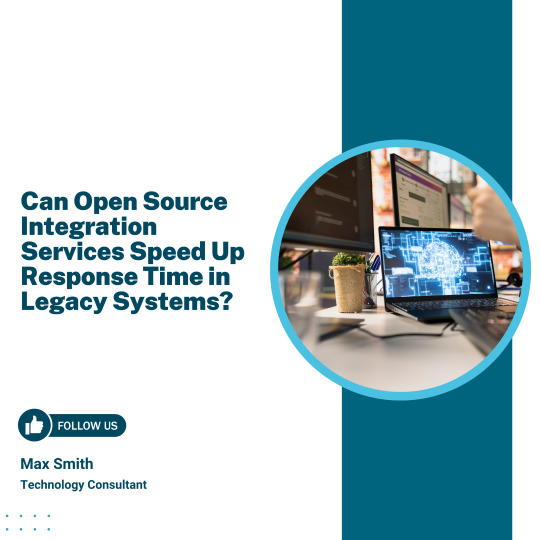
Why Faster Response Time Matters
System response time has a direct impact on business performance. According to a 2024 IDC report, improving system response by just 1.5 seconds led to a 22% increase in user productivity and a 16% rise in transaction completion rates. This means increased revenue, customer satisfaction as well as scalability in industries where time is of great essence.
Open-source integration is prominent in this case. It can minimize latency, enhance data flow and make process automation easier by allowing easier communication between legacy systems and more modern applications. This makes the systems more responsive and quick.
Key Business Benefits of Open-Source Integration
Lower Operational Costs
Open-source tools like Apache Camel and Mule eliminate the need for costly software licenses. A 2024 study by Red Hat showed that companies using open-source integration reduced their IT operating costs by up to 30% within the first year.
Real-Time Data Processing
Traditional legacy systems often depend on delayed, batch-processing methods. With open-source platforms using event-driven tools such as Kafka and RabbitMQ, businesses can achieve real-time messaging and decision-making—improving responsiveness in areas like order fulfillment and inventory updates.
Faster Deployment Cycles: Open-source integration supports modular, container-based deployment. The 2025 GitHub Developer Report found that organizations using containerized open-source integrations shortened deployment times by 43% on average. This accelerates updates and allows faster rollout of new services.
Scalable Integration Without Major Overhauls
Open-source frameworks allow businesses to scale specific parts of their integration stack without modifying the core legacy systems. This flexibility enables growth and upgrades without downtime or the cost of a full system rebuild.
Industry Use Cases with High Impact
Banking
Integrating open-source solutions enhances transaction processing speed and improves fraud detection by linking legacy banking systems with modern analytics tools.
Telecom
Customer service becomes more responsive by synchronizing data across CRM, billing, and support systems in real time.
Manufacturing
Real-time integration with ERP platforms improves production tracking and inventory visibility across multiple facilities.
Why Organizations Outsource Open-Source Integration
Most internal IT teams lack skills and do not have sufficient resources to manage open-source integration in a secure and efficient manner. Businesses can also guarantee trouble-free setup and support as well as improved system performance by outsourcing to established providers. Top open-source integration service providers like Suma Soft, Red Hat Integration, Talend, TIBCO (Flogo Project), and Hitachi Vantara offer customized solutions. These help improve system speed, simplify daily operations, and support digital upgrades—without the high cost of replacing existing systems.
2 notes
·
View notes
Text
Why Outsource Email Support and Management to ExpertCallers?
Email remains a primary channel for customer communication. With over 4.5 billion users worldwide in 2024, businesses receive thousands of emails daily. Responding quickly and accurately is essential, but internal teams often struggle to manage the volume. Delays and missed responses lower customer satisfaction and reduce retention.
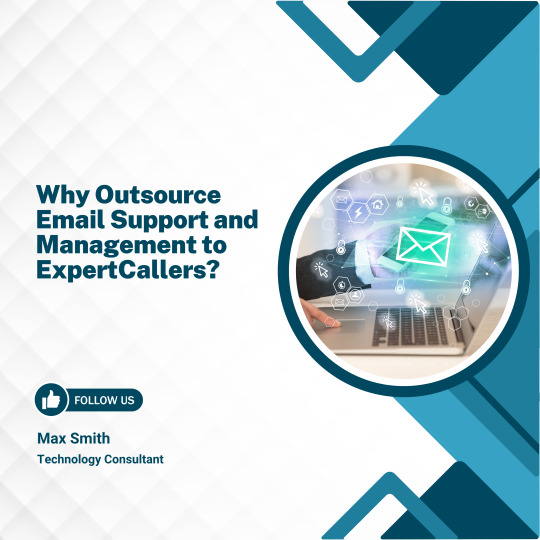
Outsource Email Support is now a smart move for businesses looking to stay efficient, scalable, and customer-focused. ExpertCallers is a company providing specialized email support and management services that can resolve these fundamental operational issues at a significantly lower overhead and help businesses achieve higher service levels without the need to increase the size of the business.
Key Benefits of Outsource Email Support to ExpertCallers
1. 24/7 Support Coverage
ExpertCallers offers 24-hour email assistance. This will ensure a quick response, regardless of the time zone. The customers do not need to wait, and the business can do continuous communications among the regions
2. Higher Resolution Rates
Trained agents handle emails with precision. Most queries are resolved on the first reply, which reduces follow-up emails and boosts customer satisfaction.
3. Cost Efficiency
Managing Outsource Email Support in-house requires hiring, training, and tech investment. Outsourcing to ExpertCallers helps reduce these fixed costs. A 2024 Deloitte report noted that 70% of companies outsource to cut expenses. ExpertCallers offers scalable plans that match business needs.
4. Strong Data Protection
ExpertCallers highly secures the data, which adheres to the international security standards, including GDPR and ISO/IEC 27001. This is to guarantee the security of sensitive information that may be transferred via email and prevent its leakage or abuse, which increases customer confidence.
5. Multilingual and Technical Support
Companies that operate in diverse markets need to provide support in multiple languages.ExpertCallers can assist in a variety of languages and they are geared to take industry specific calls as well as those which need a technical touch. This enhances access and increases the trustworthiness of the brand across the foreign markets.
6. Analytics and Reporting
Every interaction that is handled by ExpertCallers is monitored and measured. Clients are provided with periodic updates regarding the average time taken to resolve a ticket, customer satisfaction rating as well as the performance of the respective agents. These analytics assist organizations to make wise decisions and keep improving their customer support strategy.
7. No More Backlogs
Email backlogs delay service and frustrate customers. ExpertCallers use smart processes and tools to manage high volumes, especially during peak times. This reduces pending queries and ensures timely replies.
Why Choose ExpertCallers?
ExpertCallers has over ten years of experience in managing email workflows for global clients. Their team handles sales, support, and technical inquiries with clarity and professionalism. They follow strict SLAs and focus on delivering quality results. Clients benefit from faster support, better customer retention, and lower operational costs.
Leading Outsource Email Support Providers
While ExpertCallers is a trusted partner for many global businesses, other notable Outsource Email Support service providers include Suma Soft, LiveSalesman, Fusion BPO Services, and Simply Contact. Each of these providers brings unique strengths, but ExpertCallers continues to differentiate through its agility, domain expertise, and robust customer satisfaction outcomes.
Outsourcing email support is no longer a strategy in today's business environment, but rather a necessity. By outsourcing to ExpertCallers, businesses get the efficiency, scale and responsiveness of operations required to compete and grow sustainably.
#CustomerSupport#EmailSupport#Outsourcing#BusinessEfficiency#CustomerExperience#CustomerRetention#OperationalExcellence
2 notes
·
View notes
Text
What Types of Technical Issues Can Be Resolved Through Remote Desktop Support Services
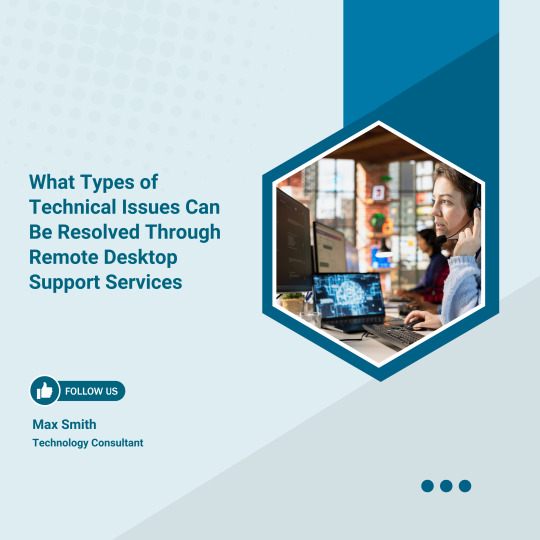
In modern business environments, system availability is critical. Any delay or disruption can impact performance, productivity, and customer satisfaction. Desktop Support Services are essential for sustaining business continuity and workforce efficiency.
According to Gartner, IT downtime can cost businesses up to $5,600 per minute. Remote Desktop Support Services mitigate this risk by offering rapid, real-time resolution—minimizing costly disruptions without the delays of on-site troubleshooting.
Common Technical Issues Solved Through Remote Desktop Support Services
Software Setup and Configuration: Remote teams can quickly deploy business applications and configure user environments,getting new employees on board fast and minimizing downtimes in employee productivity.
Operating System Errors: Issues like system crashes, failed updates, or corrupted files can be diagnosed and fixed remotely. Technicians can repair OS components or reinstall essential updates to restore normal operations.
Network Connectivity Issues: Slow speed connections, VPN issues, or internet connection disturbance can get resolved remotely through changing network settings, firewall permission and router settings.
Email and Communication Tool Errors: Downtime in communication tools such as Outlook, Microsoft Teams, or Zoom can interrupt workflows. Remote support teams fix these problems to maintain communication continuity.
Peripheral Device Support: Peripherals such as printers and webcams are also challengeable in terms of compatibility. The remote technicians fix and update drivers to draw full functionality.
Slow System Performance: Remote support can resolve speed and performance issues by clearing unnecessary files, optimizing startup processes, and improving memory usage.
Security Updates and Patch Management: Maintenance of security of systems needs updating. Remote teams can make sure that all the patches are timely installed, and vulnerabilities are minimized.
User Access and Permissions: Access issues such as forgotten passwords or locked accounts can be handled remotely by resetting credentials and adjusting user roles securely.
Virus and Malware Removal: Remote support can isolate infected devices, run antivirus scans, and remove malicious files without needing physical access.
Business Advantages of Remote Desktop Support Services
Remote Desktop Support delivers real-time issue resolution, significantly reducing system downtime and improving operational continuity.
It eliminates on-site service costs, optimizing IT spend without sacrificing quality.
Support scales effortlessly with growing teams and multiple locations, ensuring consistent performance across the organization.
With 24/7 coverage, businesses gain round-the-clock access to expert support—keeping infrastructure stable, secure, and productive at all hours.
To scale these benefits effectively, many organizations partner with experienced providers of Desktop Support Services. Some recognized names in the space include HCLTech, Suma Soft, Wipro, CompuCom, and Tech Mahindra.
Remote Desktop Support is no longer a supplemental IT feature—it’s a strategic asset. It drives business continuity, operational resilience, and employee productivity. To stay agile and competitive, organizations must prioritize a well-structured, responsive desktop support framework.
2 notes
·
View notes
Text
What Are the Key Benefits of Partnering with a Mortgage Processing Service Provider?
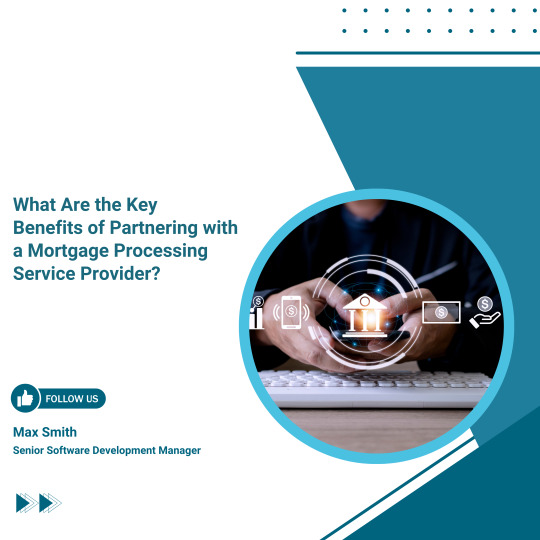
Mortgage institutions are continually working to reduce their expenses, expedite loan processing, and comply with new regulations. It becomes increasingly complicated for in-house teams to manage mortgages effectively due to manual steps, rising application volumes, and ever-changing market needs. Mortgage Processing Services contribute to the business by providing tangible results.
1. Lower Operational Costs
Handing off mortgage processing services helps companies significantly reduce costs. Service providers provide flexible ways to handle workloads without requiring you to purchase expensive hardware, or hire and train additional staff. A recent report by the MBA suggests that lenders can lower their loan processing costs by as much as 40% if they outsource. Having spare resources allows banks to work on key areas, such as growing their loan portfolio or improving how borrowers interact with them.
2. Faster Loan Processing
With the help of Mortgage Processing Services, the approval of a loan goes faster. Companies in the industry have 24/7 teams, set workflows, and automated systems that make documentation, verification, underwriting support, and closing more efficient. The framework supports smooth processing of a vast number of loans. In many situations, it takes about 30–50% less time to complete loan files, which leads to faster loan closings and happier customers.
3. Stronger Compliance and Risk Management
It is difficult and expensive for firms to update internal teams on new changes in TRID, RESPA, and HMDA rules. Mortgage processing services partners assist in meeting all necessary requirements to avoid facing penalties. They are aware of the latest regulations and use quality control measures to guarantee that every piece of documentation is properly created.
4. More Flexibility and Scalability
Outsourcing helps mortgage lenders expand or reduce their business activities as the market demands. Despite changes in demand, third-party services help companies adjust to new needs by avoiding the need to expand or scale back staff. Lenders are able to concentrate on relationships and new solutions while their partner handles the details of processing loans. This flexibility matters a lot during the busiest times of the year, during times of rapid refinance business, or when regulators come for an audit.
5. Access to Skilled Professionals and Technology
Mortgage processing services partners bring access to trained specialists in areas like pre-underwriting, closing support, and compliance review. They also use modern technology—including AI-driven document processing, digital workflow tools, and cloud platforms. These tools speed up processing, reduce manual errors, and enhance data visibility across the loan cycle. Working together, people with experience and technical solutions help the bank produce more loans and maintain better quality.
6. Data Security & Confidentiality
It is crucial to protect a large amount of sensitive data concerning individuals and their finances with strong measures. Top mortgage processing services companies use secure technology and follow rules set out by groups like ISO 27001 and SOC 2. This helps prevent data breaches and any violations of rules related to the processing of borrower information.
Conclusion
In today’s competitive mortgage industry, lenders must look outside their own systems if they want to stay profitable, follow industry rules, and meet customer expectations. Working with an expert Mortgage Processing Services provider results in more efficient procedures, less spending, and fewer worries about regulations. Working with skilled professionals, advanced technologies, and flexible partnership models creates value throughout the process of handling a loan. There are several reliable organisations active in the space, some of which are Suma Soft, Flatworld Solutions, Sourcepoint, Infosys BPM, and Cognizant Mortgage Services. These companies offer extensive knowledge about mortgage lending and custom services that meet lenders’ new requirements around the world.
3 notes
·
View notes
Text
Mortgage underwriting process—How long does it take?
In the world of mortgages, underwriting is required to confirm a person’s eligibility for a loan. Improvements in the process save on approval, ensure satisfaction for borrowers, speed up the lending process and raise lenders’ revenue waves. Late underwriting leads to more loan fallouts, makes borrowers less confident and negatively influences the total number of closed loans.

Understanding the Timeline
The standard underwriting timeline ranges from five to twenty business days, depending on internal workflows, borrower profile, and documentation quality. According to the Mortgage Bankers Association, the moderate loan closes in 44 days, with underwriting taking approximately a third of that duration.
The process includes:
Initial Review: Verification of borrower income, credit history, debt-to-income ratio, and property appraisal.
Conditional Approval: Requests for missing documentation or clarification.
Final Approval and Clear-to-Close: Completion of all checks before funding.
In reality, the complexity of each file influences processing time. Loans with multiple sources of income, self-employment history, or appraisal discrepancies can require additional scrutiny. When internal underwriting teams are overburdened, processing times increase and margins shrink.
Business Impact of Delays
Operational delays in underwriting don’t just inconvenience applicants—they directly affect revenue cycles. For lenders operating at scale, a one-day delay in underwriting across 1,000 loans can represent over $300,000 in deferred closing revenue, based on average mortgage values.
Moreover, missed closing dates reduce borrower satisfaction and increase the risk of loan fallout. According to STRATMOR Group, fallout rates can rise by 15% when underwriting extends beyond ten business days.
Reducing Turnaround Time with Underwriting Support Services
Outsourcing underwriting support services is now a strategic decision rather than a cost-saving tactic. Lenders experiencing high application volumes, regulatory complexity, or staffing gaps have shifted toward Underwriting Support Services to manage scale without compromising compliance.
Key advantages include:
Scalability: Underwriting support teams can process high volumes without extending timelines.
Risk Mitigation: Access to trained specialists ensures accuracy in compliance-heavy reviews.
Faster TATs: Service-level agreements (SLAs) allow lenders to maintain predictable turnarounds, often within 24–48 hours.
Cost Optimization: On-demand support reduces the need for permanent staffing during seasonal surges.
According to Deloitte’s 2024 Mortgage Industry Report, more than 54% of mortgage lenders are either outsourcing or planning to outsource underwriting and related support functions to improve processing speed and compliance coverage.
Selecting the Right Partner
Certainly. Here is how the revised version should look:
Reliable underwriting support services is key to ensuring regular enhancements in your operations. It is important for an effective provider to have experience with different types of mortgage loans and be familiar with the rules of Fannie Mae, Freddie Mac, FHA and VA. Maintaining a high level of loan processing by flexibly managing engagement is essential. The provider should also ensure data protection and follow important regulatory standards, including those denoted by SOC 2 and ISO certifications.
Several organizations excel in offering Underwriting Support Services with these skills. Seven of the companies include Suma Soft, Sutherland Mortgage Services, SLK Global Solutions, WNS (Holdings) Limited and Indecomm Global Services. Each company customizes their offerings so that mid-sized lenders, credit unions and large financial institutions can perform successfully and meet quality standards all the way through mortgage processing.
Conclusion
Workflow strategies are necessary to avoid bottlenecks in the mortgage underwriting process. Integrating Underwriting Support Services allows lenders to handle approvals faster, lower the risk of irregularities and give borrowers reliably good service. Organizations in this competitive market must be efficient in their underwriting, as it is no longer an option—it is essential for success.
2 notes
·
View notes
Text
How Outsource Insurance Underwriting Services Improve Risk Assessment Accuracy

The importance of accurate underwriting in insurance has increased, helping to decrease risks, build trust among customers and keep operations efficient. Companies in the insurance industry are expected to give quick responses while still managing risks well. Utilizing outsource insurance underwriting has become popular, as it accurately measures risks at a lower cost.
As operating in the insurance sector becomes more demanding, firms are trying out operational models that combine speed and high quality. Using outsource insurance underwriting is an example of a plan that blends people’s capabilities, automation and using information. Outsourcing tasks helps insurers handle work better, offer more efficient services and check underwriting for errors. Now, it helps create consistent processes for underwriting, meet customer demands and follow regulations in various areas.
1. Better Risk Assessment Through Technology and Process Control
Outsourced underwriting providers use structured processes, digital platforms, and automated decision tools. These systems analyze large volumes of data, detect inconsistencies, and apply risk rules more consistently than manual reviews. As a result, underwriting becomes more reliable. According to a Deloitte study, 61% of insurers using outsourced models saw better accuracy in their underwriting decisions.
2. Access to Experienced Underwriting Talent
Outsourcing partners maintain trained underwriting teams across multiple insurance lines—life, health, property, and casualty. These professionals follow strict underwriting guidelines and undergo regular training. Their experience reduces decision errors, even with complex risk profiles. A McKinsey report noted that insurers working with external underwriters cut their average underwriting time by 35% and reduced rework by 28%.
3. Lower Operational Costs with Scalable Capacity
Hiring, training, and maintaining an internal underwriting team requires high ongoing investment. By outsourcing insurance underwriting, insurers shift to a flexible cost model. Service providers manage staffing, infrastructure, and compliance at scale. This helps insurers save money and adjust quickly to market demands—without slowing down operations or quality.
4. Stronger Compliance and Risk Control
Outsourced underwriting firms work under formal Service Level Agreements (SLAs). These contracts ensure that all activities follow regulatory requirements, such as HIPAA, GDPR, and country-specific insurance laws. Outsourcing partners also maintain audit-ready documentation and track every transaction. PwC found that insurers using outsourced models improved audit readiness by 40% and reduced compliance issues by 25%.
5. Focus on Strategic Growth
By outsourcing routine underwriting tasks, insurers free up internal teams for higher-value work. This includes developing new products, improving customer experience, and expanding into new markets. Outsourcing removes time-consuming operational bottlenecks, helping insurers grow without increasing headcount.
Leading Outsource Insurance Underwriting Providers
Several recognized firms offer outsource insurance underwriting support at scale. These include EXL Service, Xceedance, Infosys BPM, and WNS Global Services. Outsourcing insurance underwriting is no longer just a cost-cutting move—it’s a way to improve accuracy, scale operations, and strengthen compliance. With the right partner, insurers can increase efficiency, reduce risk, and improve time-to-decision without sacrificing quality.
2 notes
·
View notes
Text
What are the benefits of outsourcing email support services?
Outsourcing email support is no longer just a cost-cutting move. It has become a Strategic move to ensure faster response times, consistent availability, and scalable customer care. With customer expectations rising, many companies now choose to outsource email support to handle increasing volumes without affecting service quality.
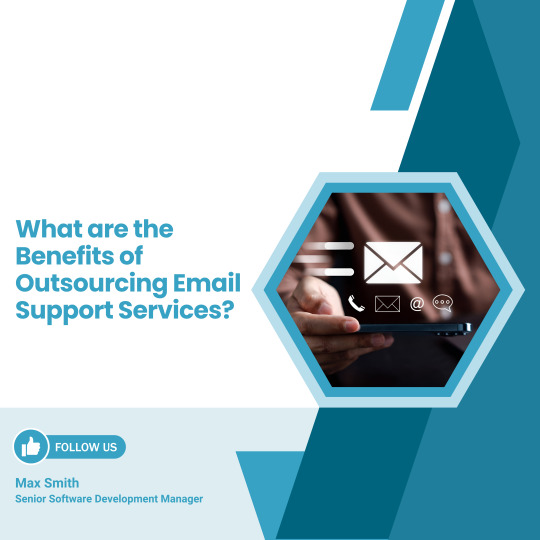
1. Lower Operational Costs
Managing an in-house email support team requires high investment in salaries, infrastructure, training, and software. Outsourcing helps reduce these fixed costs. According to Deloitte, 59% of companies outsource to cut expenses. By choosing an external partner, businesses can lower support costs while maintaining high service standards.
2. 24/7 Customer Service
Customers often send emails outside of business hours. Outsourcing ensures full-day, year-round support without managing multiple internal shifts. A Statista survey found that 51% of customers expect businesses to be available at all times. With outsource email support, companies can meet this expectation and improve response reliability.
3. Faster Response and Resolution
External teams work with set SLAs and have trained agents who can quickly manage large volumes of queries. using optimized workflows and automation tools. A Forrester report shows that 66% of customers value quick service as their top priority. Outsourcing helps meet this need effectively.
4. Expert Support and Advanced Tools
Outsource Email support providers use modern tools and platforms for ticket tracking, analytics, and automation. Teams are multilingual and trained in domain-specific customer handling. Businesses benefit from skilled teams and better tools—without having to build these systems themselves.
5. Easy Scaling During High Demand
Fluctuations in demand such as those caused by sales, products or promotions, can cause spikes in the amount of customer contact. Email Support teams can be scaled up or down according to the number of customers requiring assistance. As a result, the system can easily manage busy times and ensure the same high standard of service.
6. Better Compliance and Quality Control
Outsource Email support services adhere to strict standards when dealing with people’s data and privacy. If you use a provider certified with ISO 27001 or SOC 2, they will provide you with well-organized compliance plans. With outsourcing, the risk of breaks in law and operation is reduced through effective data security and it is simpler to conduct audits, train employees and uphold quality.
Trusted Email Support Service Providers
There are many providers who offer trustworthy, flexible email support for businesses. Suma Soft, Fusion BPO Services, Triniter and TaskUs regularly provide consistent and industry-compliant support for ecommerce, SaaS, healthcare and telecom sectors.
Choosing to outsource email support helps businesses cut costs, respond faster, stay available 24/7, and deliver better service at scale. It enables companies to focus on growth while expert teams handle support operations efficiently.
1 note
·
View note